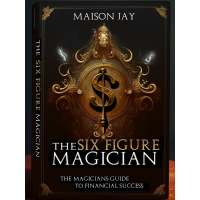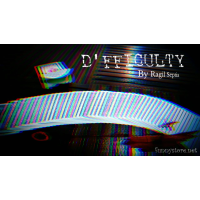The Big Book Of Rising Cards by Claude Klingsor
- Product Code: B1#123
- Reward Points: 30
- Availability: In Stock
- $13.48
-
$6.99
- Price in reward points: 699
This is the most beautiful magic book ever published!I know, this is a pretty strong claim, but read on and judge for yourself.
"I've just had a chance to spend a couple of hours with this book. Wow, Chris. This is an amazing book. Not only does it look incredible, it is of immense historic value. "-Ben Harris
"A terrific work, a must have for anybody who thinks of him- or herself as a magician. "- Max M.
Before I tell you why I am convinced this is the most beautiful magic book ever published, allow me to give you a bit of history on how this book came to be.
In 1954 Claude Klingsor published an encyclopedia of rising card tricks in French under the titleLes tours de cartes montantes. It was produced in a small print run, quickly sold out, and vanished into the private libraries of lucky magicians who picked up a copy. Even though it was the most comprehensive encyclopedia of the rising cards ever compiled it never was translated into English. It is quite fascinating how such a pearl of magic literature could practically vanish. However, if this would be all there is to it I would not have made the claim I made before. Fast forward a couple of decades ...
Fabrice Delauré enters the stage Fabrice, an innovative young creator and producer of magic, had one magic hero -. You guessed correctly - Claude Klingsor And one of his dreams was to update and upgrade Klingsor's encyclopedia of rising cards Fabrice and Claude teamed up .. and updated and expanded on Claude's original work to create an even more complete and accurate encyclopedia. However, if this would be all there is to it I would not have made the claim I made at the top. It would be an authoritative encyclopedia of the rising cards, quite a unique book, but I could not claim it to be the MOST BEAUTIFUL MAGIC BOOK.
The defining difference of the new edition Fabrice published is that every gimmick, apparatus and equipment described in the book, and there are many, was first created in a 3D computer aided design (CAD) software -. A solid modeling tool And then from this digital 3-dimensional representation an illustration was created through rendering akin to the latest graphics effects in Hollywood blockbuster movies. This allowed for wonderful see-through and cross-cut illustrations unlike any you have seen in a magic book. The amount of work as you can imagine was staggering. Think about how long it takes to model even a simple box with a lid in a 3D CAD tool. Every piece has to be drawn and properly aligned to the other parts. Material properties have to be specified. And then to actually create an illustration camera and lights have to be positioned properly. And now do this literally dozens of times with objects consisting of many individual parts. It is at least an order of magnitude more time consuming to create a 3D object than to simply draw a 2D representation. It is almost the difference between actually building each piece rather than merely describing it.
When I first saw the book I could not believe my eyes. I have used 3D CAD software before and I immediately knew that only a perfectionist and crazy fanatic of magic would ever attempt to do anything like it. I think it is unlikely that anybody would try something similar. It is a labor of love. The only problem was that again this was only published in French. I knew that I had to bring this most beautiful magic book to a larger audience. I bought the English language rights, had it translated, and am now able to offer it to you.
[Printed edition:Even though I strongly prefer ebooks this book does gain when printed. It took me four test prints with two different printers to find the quality I was happy with. I settled with the printer who uses an Indigo printing machine. This is considered the best digital printing machine on the market today. It uses liquid ink rather than powder based toner as all other digital printing machines do. The book turned out stunningly beautiful.
It is a large format book with color cover and color chapter separators. It has a soft cover with a satin UV coating to assure longevity and reduce the visibility of finger prints. The inside is printed on heavy semi-gloss paper. It is hard to describe the beauty and the visual appeal when held open.]
Now that you know about the one-of-a-kind production values ??of this incredible publication, let me tell you about the actual contents. Encyclopedic works are rare because it takes a lot of time to collect and document anything in an encyclopedic fashion Nevertheless, it is quite amazing that nobody besides Klingsor in his French original has tackled the rising cards -. probably the most memorable and strongest effect possible with cards We have encyclopedias of rope tricks and cigarette effects, even tricks with eggs were described in an encyclopedic. fashion. Why not rising cards? The most comprehensive collection to date besides this work can be found inGreater Magic, But it is by no means encyclopedic. And magic with the pasteboards is by far the most popular kind of magic performed and studied.
"The rising cards is one of my pet effects and I have studied it for many years both from a performance point of view as well as from a historical and method point of view. I opened this book with the attitude that I would probably already know pretty much everything described here. Oh boy was I wrong! For me personally this is not just the most beautiful book it is the most important magic book of recent history. "- Peter Kent
"Probably the most complete collection of information about the Rising Cards and its variations. Definitely the most beautiful book. Thurston would have grabbed this in a minute, and mystified more than one Herrmann. I've spent hours with this book already , and look forward to spending hours more. With the knowledge from this book, you'll always be able to perform the Rising Card (s), no matter your venue, no matter your audience. "- Chet Cox (Grandpa Chet)
You will learn methods based on sleight-of-hand, threads, clock mechanisms, rubber bands, springs, sand, gravity and many many more.
- Table of Contents
- Preface
- Introduction
- Chapter 1: A Little History
- Chapter 2: The Rising Cards and the Audience
- Chapter 3: Definition and Classification
- Chapter 4: Regular Rising Card Tricks
- Manual Tricks
- Regular Cards
- Prepared Cards
- Non Automatic Processes
- Thread system
- Hair and wax ball system
- The climbing cards
- The flying cards
- Processes requiring a riser
- Processes requiring a magic wand
- Processes requiring a cut out
- Processes requiring a highly sharpened rod
- Houlette using various processes
- The rising cards box
- Various processes used in rising card tricks
- Automatic and Semi Automatic Processes
- Release of a rubber band
- Release of a spring
- Gravity
- Clock movement
- Hydrostatic force
- Swinging of a pendulum
- Manual Tricks
- Chapter 5: Universal and On-Demand Rising Card Tricks
- Fake Universal Rising Cards
- The Thurston process
- The Ceillier process
- The rising cards with a table mat (Dinsart)
- The rising cards with a flat pipe
- Universal Rising Cards Strictly Speaking
- Barini's detective card
- Guimard's cards on request
- The Slygo houlette
- The Neyhart houlette
- The houlette with cut out cards
- The Stull houlette
- Dr. Hooker's houlette (for a comprehensive treatise seeSamuel Cox Hooker and His Rising Cards)
- Fake Universal Rising Cards
- Chapter 6: Fifty Years Later
- Card Tricks with Apparatus: Non-Automatic Processes
- Thread and hair system
- Systems requiring a riser
- Various systems
- Automatic and Non-Automatic Processes
- The Max Haug houlette
- Richard Himber's solid gold gimmick
- Devano deck improvements (AMY, Arne, etc.)
- Klingsor's mechanical deck
- Electronic rising card decks
- Electronic rising card pack, bridge or poker size
- The supreme houlette
- Giant and mammoth rising card decks
- Card throwers
- The card fountain
- The triple houlette (Klingsor)
- About Dr. Hooker's houlette
- Deck Switches
- The swapping with a tray
- The swapping with a box
- Klingsor's swapping box
- The triple houlette (Klingsor)
- Card Tricks with Apparatus: Non-Automatic Processes
- Chapter 7: Practical Advice
- Conclusion
- Index and Bibliography
- French Books
- English Books
- German Books
- Dutch Books
- Italian Books
- Index
1st edition 2010; 211 pages.
word count: 71236 which is equivalent to 284 standard pages of text
Reviews (0)
Related Products
Mentalism With Cards by Paul Hallas
Paul Hallas is the author ofMindful Mentalism, Series of books,Mental Mix,Magic From the Overground,..
$2.99 $14.68
The Annotated Erdnase by Darwin Ortiz
Darwin Ortiz - The Annotated ErdnasePDFThere has been a lot of talk about SW Erdnase lately. And, wh..
$1.99 $7.48
Albo 06 - Final Classic Magic With Apparatus by Robert J. Albo
The Sixth of the Dr. Albo Books in a strictly limited edition.Details: This is one of..
$19.99 $92.99
The Big Book Of Magic Table Plans (1-5) by Steve Kovarez
Steve Kovarez - The Big Book of Magic Table Plans Vol 1 - Budget Tables15 ideas and designs with mea..
$6.99 $58.00
Samuel Woolf Code by Bruce Kalver
PDFTHE MOST TALKED ABOUT EFFECT IN BRUCE'S LECTUREThis code can be learned in five minutes or less. ..
$1.99 $5.99
Fast Forward by Victor Sanz and João Miranda
What happens when you take a classic comedy gag and supercharge it with jaw-dropping visuals and a s..
$2.99 $13.99
Recommend
aStockholm By Geni
a very cool card trick from Geni+ Borrowed deck of card+ Easy to do+ No gimmick+ Stunning reactLet's..
$1.99 $8.00
Something to think about By Joseph B
Something to think about by Joseph B. is something to think about for the sleight of hand magician t..
$0.50 $2.00
MACAAN (Presented by Craig Petty) By Matt Mello
"Very clever! A more diabolical or easier card at any number has yet to be created. This is within t..
$1.99 $9.95
CONCEALED By Peter Eggink
An ultra quick and ultra easy card to pocket.Any card is selected and is signed by the spectator. Ne..
$1.99 $39.95
John: Verse Two By John F. Mendoza
Viking Enterprises. 1982 Second Edition. Paperback, spiral bound in brown plastic. B&W illustrat..
$3.99 $35.00
Psychic Psingularities By John Riggs
Psychic Psingularities. Routines, ideas and tips from me, Jack Dean, C.L. Borde, Sal Franchino, Fred..
$3.99 $0.00
Florentine Assembly - Music act By Giacomo Bertini
I am very happy to show you this routine with the explanation! This is a new version of my original ..
$1.99 $11.95
Freeway By Negan
play a card game with only 8 playing cards and predict exactly what final card is+Easy to do+Work 10..
$1.99 $8.00
The Six Figure Magician By Maison Jay
"The 6-Figure Magician" is a must-read book for any aspiring or established magician looking to take..
$4.99 $24.99
Wordless By Emma Wooding
The First Book In The 'Less' trilogy!Wordless is my brand new word divination where with nothing wri..
$0.99 $5.00
Returning Tiger By Aurélio Ferreira
The magician takes a pull off of a can and with a magic pass the pull is restored back on to the can..
$1.99 $10.00
Poor Man's PK Pen By Ralf Rudolph aka'Fairmagic
In this Videos Download you will learn how to make your own PK Pen with household items.No Electroni..
$3.99 $20.00
Vanish By Justin Miller
Vanish a deck with zero coverAlmost 50 years ago, the nomadic magic creator; Paul Harris, created th..
$2.99 $15.00
Manifest By Dominicus Bagas(Video+PDF)
A trick with a powerful message!No complicated gimmicksSetup in a minutesNo sticky stuffEasy to rese..
$6.99 $17.00
STATIC By Patricio Teran
By rubbing your hands a little and creating enough friction, the ring on the can jumps incredibly, t..
$1.99 $10.00
D'FFICULTY By Ragil Septia
this effect reminds us of the power of hypnosis.. but this time, you don't have to understand hypnos..
$1.99 $9.00























